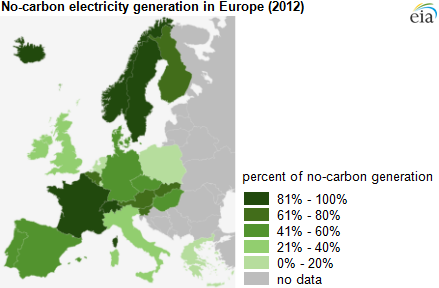October 24, 2014 – The original goal was to cut greenhouse gas emissions (GHGs) by 20% from 1990 levels by the year 2020. But the European Union (EU) leadership is getting far more aggressive in moving away from fossil fuels. The plan has some of the Eastern members, former Soviet-dominated countries, up in arms because their dependence on coal-fired power is far greater than average. A country like Poland, the strongest Central European economy among the old Warsaw pact, is looking to some free carbon credits from the EUs carbon emissions trading exchange, a system also known as cap-and-trade, to help offset its current coal dependency. The fear for Poland is a spike in electricity costs and a lack of investment in renewable infrastructure as it decommissions legacy coal-fired power plants.
Part of the commitment to a lower carbon economy involves boosting renewable energy by 27% by 2030. The EU is also establishing a 30% energy efficiency improvement target with a goal to decrease per capita consumption of energy across the continent. Resistance again is coming from the Central European states formerly aligned with the Soviet Union.
Part of the EU’s plan includes improving the sharing of power across national borders. Currently only 8% of power crosses boundaries although the goal of 10% was endorsed by European leaders back in 2002. So a push for a stronger energy union is incorporated into EU planning.
The GHG emissions goal is expected to cost the EU members $48 billion US per year and place the Community at the forefront in fighting global warming. The EU Climate Commissioner, Connie Hedegaard pointedly indicated in her comments that this is a heads up to nations and business. She remarked, “nothing gets easier by postponing, nothing gets cheaper…..investors, businesses, everyone will know that this is where we are headed – these are the targets.”
Europe has been aggressively pursuing no-carbon power generation. In recent years EU countries have seen renewables dramatically increase led by Germany. Eighteen countries in the EU in 2012 generated at least one-third of their electricity requirements from non-carbon sources and thirteen generated half. The map below illustrates Europe’s progress to achieve its emission target goals.
The United States, China and Canada are trailing in achieving anything close to what the EU has done to date or set in its new 2030 goals. Europeans hope they are sending a strong signal to other big world economies to establish similar aggressive targets in preparation for the upcoming climate summit in Lima in December of this year and the subsequent meeting planned for Paris in 2015.













Wonderfuel news Thank you EU